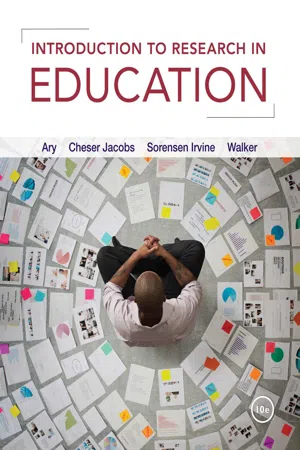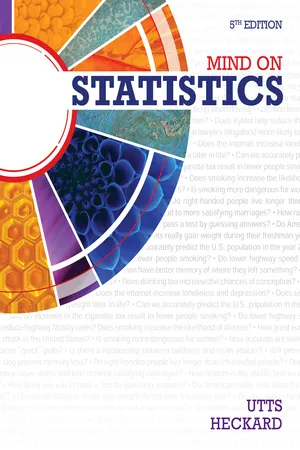Mathematics
Conducting a Survey
Conducting a survey involves gathering data from a sample of individuals to make inferences about a larger population. This process typically includes designing the survey questions, selecting the sample, collecting the data, and analyzing the results. In mathematics, survey data can be used for statistical analysis and to draw conclusions about a population.
Written by Perlego with AI-assistance
Related key terms
1 of 5
5 Key excerpts on "Conducting a Survey"
- eBook - PDF
- Adil Akinci(Author)
- 2019(Publication Date)
- Peter Lang Group(Publisher)
Selim Tuzunturk Fundamentals of Sample Survey Research: A Statistical Perspective 1 Introduction Science is the most trustworthy way of acquiring reliable and valid knowl- edge about the natural world (Nayak and Singh, 2015: 6). The science of sta- tistics is essentially a branch of Applied Mathematics, and may be regarded as mathematics applied to observational data (Fisher, 1934: 1). Statistics is a mathematical discipline that describes procedures for deriving results about a population from sample data (Romejin, 2011: 751). Data is collected by three techniques: Experiment, observation, and survey (Bülbül, 2006: 58). Experiment technique is a scientific test that is done to find out how something reacts under certain conditions, or to find out if a particular idea is true (Longman Dictionary, 2003: 548). Laboratory conditions needed for experiment is used mostly in physical and health sciences. Observation is the action of observing something or someone and involves the recording of data. The best way to know how people act and think is to observe them repeatedly and directly over time (Polland, 1998:1). However, it is not possible to follow all people, and to record their behaviors. Moreover, some kinds of behaviors such as attitudes, beliefs, and opinions cannot be observed directly (Polland, 1998:1). In the present case, researchers apply a practical research tool, which is known as a survey. A survey is an activity that collects information in an organized and methodical manner about the characteristics of interest from some or all units of a population using well-defined concepts, methods, and procedures, and compiles such information into a useful summary form (Franklin and Walker, 2003: 1). It is a set of questions that you ask a large number of people in order to find out about their opinion or behavior (Longman Dictionary, 2003: 1673). It is often the best way to get information and feedback to use in planning (Hart and et al., 2010: 4). - eBook - PDF
- Donald Ary, Lucy Jacobs, Christine Sorensen Irvine, David Walker(Authors)
- 2018(Publication Date)
- Cengage Learning EMEA(Publisher)
3. Sampling . Because researchers generally cannot survey an entire population, they select a sample from that population. It is very important to select a sample that will provide results similar to those that would have been obtained if the entire population had been surveyed. In other words, the sample must be representative of the population. The extent to which this happens depends on the way subjects are selected. The sampling procedure that is most probable to yield a representative sample is some form of probability sampling (see Chapter 8). Probability sam-pling, based on the concept of random selection, permits you to estimate how far sample results may deviate from the population values. sampling frame A complete list of all individuals in the population. Copyright 2019 Cengage Learning. All Rights Reserved. May not be copied, scanned, or duplicated, in whole or in part. Due to electronic rights, some third party content may be suppressed from the eBook and/or eChapter(s). Editorial review has deemed that any suppressed content does not materially affect the overall learning experience. Cengage Learning reserves the right to remove additional content at any time if subsequent rights restrictions require it. CHAPTER 13 SURVEY RESEARCH 319 4. Constructing the instrument . A major task in survey research is constructing the in-strument that will be used to gather the data from the sample. Two basic types of data-gathering instruments are interviews and questionnaires. 5. Conducting the survey . Once a data-gathering instrument is prepared, it must be field tested (i.e., via a pilot test) to determine if it will provide the desired data. Also included in this step are training the users of the instrument, interviewing subjects or distributing questionnaires to them, and verifying the accuracy of the data gathered. 6. Processing the data . The last step includes coding the data, statistical analysis, inter-preting the results, and reporting the findings. - No longer available |Learn more
- Jessica Utts, Robert Heckard(Authors)
- 2015(Publication Date)
- Cengage Learning EMEA(Publisher)
148 5 How many people would like to fly to the moon? See Example 5.4 (p. 154) Copyright 2014 Cengage Learning. All Rights Reserved. May not be copied, scanned, or duplicated, in whole or in part. Due to electronic rights, some third party content may be suppressed from the eBook and/or eChapter(s). Editorial review has deemed that any suppressed content does not materially affect the overall learning experience. Cengage Learning reserves the right to remove additional content at any time if subsequent rights restrictions require it. 149 Sampling: Surveys and How to Ask Questions Space/NASA Sites 149 P eople are curious about each other. When a newsworthy event occurs, people want to know what others think. In the midst of election campaigning, people want to know which candidates are in the lead. We devour news stories about the behavior and opinions of others. For this reason, news organizations such as USA Today and CNN often conduct sample surveys. Many recent surveys can be found on the Web. In this chapter, we learn how to conduct surveys, how to make sure they are representative of the whole population, and what can go wrong. 5.1 Collecting and Using Sample Data Wisely Remember that there are two major categories of statistical techniques that can be applied to data. The first is descriptive statistics , in which we use nu-merical and graphical summaries to characterize a dataset or describe a rela-tionship between two variables. We learned many ways to describe variables in Chapter 2, and we learned how to describe relationships between two variables in Chapters 3 and 4. The second important category of statistical techniques is inferential sta-tistics , in which we use sample data to make conclusions about a broader range of individuals than just those who are observed. In Chapter 4 we learned about hypothesis testing , in which we used a sample to infer whether or not a real relationship existed in a population. - eBook - PDF
- Gün R Semin, Klaus Fiedler, Gün R Semin, Klaus Fiedler(Authors)
- 1996(Publication Date)
- SAGE Publications Ltd(Publisher)
The questions may be asked in face-to -face or telephone interviews, or by means of a self-administered questionnaire, which may be mailed to respondents. Following data collection, the answers must be coded for data analysis. Data analysis, interpretation of the results, and dissemination of the find ings complete the research process. Next, we consider some of the key elements. More detailed discussions of many of these issues are provided by Bradburn and Sudman (1988), Schuman and Kalton (1985), and Weisberg, Krosnick and Bowen (1989). Who to ask: populations and samples The research objectives determine the population from whom data are to be collected. This may be the adult popUlation of a country (as in national opinion polls), the members of an organization or patients suffering from a particular illness, but also the population of hospitals or car dealers in a country or in some specif ied region, and so on. As noted above, if data are gathered from all members of the population, the study is called a census. In most cases, however, this is not feasible and a sample will be drawn instead. Drawing inferences from the sample to the larger population of interest requires that the sample be representative of that population. A biased sample, i.e . a sample that does not represent all parts of the sampling frame, will be devastating to the validity of the obtained survey results. Reflecting its crucial importance, survey sampling is a highly specialized field in its own right (see Kalton, 1 983, for a mathematically oriented introduction and Sudman, 1 976, for a nonmathematical discussion of applied sampling issues). Anyone who plans a survey is well advised to secure the services of a professional sampling statistician. At a basic level, we can distinguish probability and nonprobability samples. A probability sample requires that each member of the population have a specifiable likelihood of being included in the sample. The most basic form of - eBook - PDF
Incidental Trainer
A Reference Guide for Training Design, Development, and Delivery
- Margaret Wan(Author)
- 2013(Publication Date)
- CRC Press(Publisher)
125 © 2010 Taylor & Francis Group, LLC 14 Conducting Meaningful Surveys 14.1 WHY YOU WANT TO KNOW ABOUT SURVEY DESIGN You are a subject-matter expert and incidental trainer. Why would you want to know about conducting surveys, which is what researchers do? Surveys can serve as useful tools that help you gather necessary data during several processes in a training program: • Needs assessment • Testing and assessment • Course evaluation • Program validation When you perform a training needs assessment to determine the gap between desired and actual employee performance, you can solicit input from employees and their supervisors through surveys. After the training, one way to assess trainees’ transfer of learning to on-the-job application is by collecting feedback from stakeholders including customers. Reaction surveys are used to evaluate individual training courses and the whole training program. Although you can obtain information informally, solid data and statistics are much more powerful, especially in assessing program effectiveness and garnering organizational support (Phillips, 1996, 46). Surveys involve sampling, data collection, and data processing. Sampling and data processing methodologies are beyond the scope of this book. The focus of this chapter is on data collection and how to maximize data quality and minimize bias so as to produce meaningful information. The fact that most of your surveys are probably carried out within an organization, as opposed to the general population, does not negate the need to employ strategies that would enhance the quality of your data. Employees do not automatically respond to a survey or tell you their true opinions. Poor data quality can lead you on the wrong path in your attempt to provide effective training. 14.2 WHAT AFFECTS DATA QUALITY Surveys collect data by asking respondents a set of questions.
Index pages curate the most relevant extracts from our library of academic textbooks. They’ve been created using an in-house natural language model (NLM), each adding context and meaning to key research topics.




